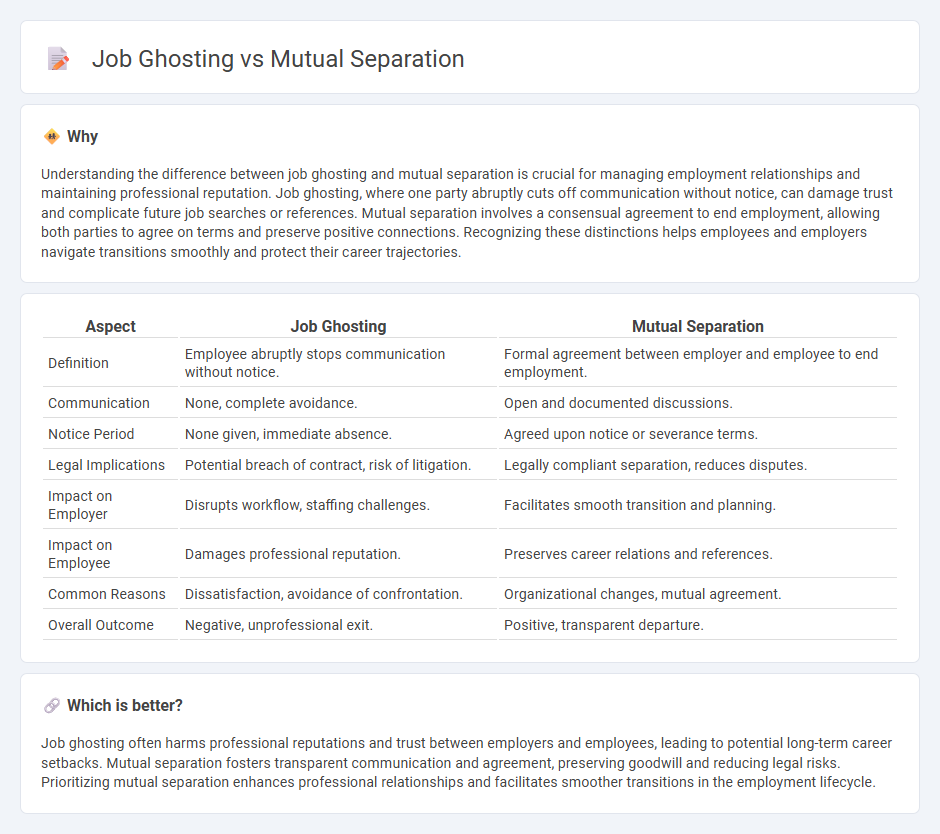
Job ghosting occurs when an employee or employer abruptly ends communication without formal notice, causing uncertainty and disruption in the employment process. Mutual separation involves a consensual agreement between both parties to part ways amicably, often with negotiated terms such as severance or notice periods. Explore the key differences and implications of job ghosting versus mutual separation to navigate your employment decisions effectively.
Why it is important
Understanding the difference between job ghosting and mutual separation is crucial for managing employment relationships and maintaining professional reputation. Job ghosting, where one party abruptly cuts off communication without notice, can damage trust and complicate future job searches or references. Mutual separation involves a consensual agreement to end employment, allowing both parties to agree on terms and preserve positive connections. Recognizing these distinctions helps employees and employers navigate transitions smoothly and protect their career trajectories.
Comparison Table
| Aspect | Job Ghosting | Mutual Separation |
|---|---|---|
| Definition | Employee abruptly stops communication without notice. | Formal agreement between employer and employee to end employment. |
| Communication | None, complete avoidance. | Open and documented discussions. |
| Notice Period | None given, immediate absence. | Agreed upon notice or severance terms. |
| Legal Implications | Potential breach of contract, risk of litigation. | Legally compliant separation, reduces disputes. |
| Impact on Employer | Disrupts workflow, staffing challenges. | Facilitates smooth transition and planning. |
| Impact on Employee | Damages professional reputation. | Preserves career relations and references. |
| Common Reasons | Dissatisfaction, avoidance of confrontation. | Organizational changes, mutual agreement. |
| Overall Outcome | Negative, unprofessional exit. | Positive, transparent departure. |
Which is better?
Job ghosting often harms professional reputations and trust between employers and employees, leading to potential long-term career setbacks. Mutual separation fosters transparent communication and agreement, preserving goodwill and reducing legal risks. Prioritizing mutual separation enhances professional relationships and facilitates smoother transitions in the employment lifecycle.
Connection
Job ghosting and mutual separation intersect in employment as both involve a breakdown in communication between employer and employee. Job ghosting occurs when one party abruptly ceases contact without notice, leading to unexpected terminations or resignations. Mutual separation agreements can help mitigate risks associated with ghosting by formalizing exit terms and ensuring clear communication during the offboarding process.
Key Terms
Voluntary Agreement
Mutual separation involves a voluntary agreement between employer and employee to end the employment relationship amicably, often with negotiated terms and clear communication. Job ghosting occurs when an employee abruptly stops responding without notice, creating uncertainty and potential disruption for the employer. Discover more about the differences and best practices for managing voluntary agreements and avoiding ghosting.
Communication
Mutual separation involves transparent and respectful communication where both employer and employee agree to end the working relationship on clear terms, fostering professionalism and future networking opportunities. Job ghosting, characterized by abrupt and unexplained silence from either party, damages trust and undermines workplace integrity. Discover effective communication strategies to navigate and prevent these scenarios.
Unilateral Disengagement
Unilateral disengagement describes a situation where an employee abruptly stops communication and participation without mutual agreement, distinguishing it from mutual separation that involves consensual decisions between employer and employee. Job ghosting leads to significant disruptions in workflow, increased recruitment costs, and strained workplace relationships due to lack of notice and communication. Explore the implications and strategies to manage unilateral disengagement in employment contexts for a better understanding of mitigating job ghosting impacts.
Source and External Links
Mutual Separation Agreement: What is it? Key Sections - A mutual separation agreement is a legal document outlining the terms and conditions agreed upon by an employer and an employee to amicably end their employment relationship, including details like termination date, severance pay, confidentiality, and release of claims.
How does a mutual separation agreement work? - It is an agreement ensuring an amicable separation that protects employers from legal disputes and allows employees to leave on good terms without negative marks on their resume, often containing confidentiality and non-disparagement clauses.
Navigating mutual separation agreements: When and how ... - A mutual separation provides flexibility and agency to both employer and employee to negotiate terms and timing of the employment cessation, helping to deescalate difficult conversations and support succession planning.
 dowidth.com
dowidth.com